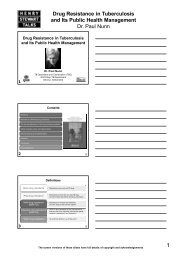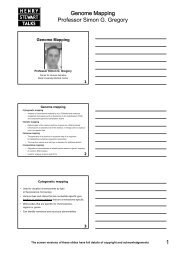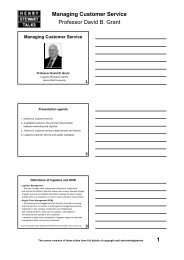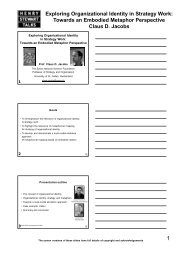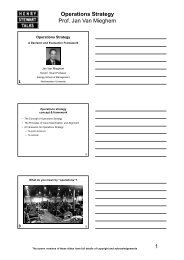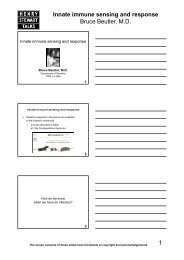Quantitative Financial Risk Management - Henry Stewart Talks
Quantitative Financial Risk Management - Henry Stewart Talks
Quantitative Financial Risk Management - Henry Stewart Talks
You also want an ePaper? Increase the reach of your titles
YUMPU automatically turns print PDFs into web optimized ePapers that Google loves.
<strong>Quantitative</strong> <strong>Financial</strong> <strong>Risk</strong> <strong>Management</strong><br />
10. Measures of financial risk<br />
Nature of financial risk – Representing financial risk using a<br />
density function – VaR as a risk measure – Expected shortfall –<br />
Coherent risk measures – Worst-case scenario analyses<br />
Prof. Kevin Dowd – Professor of <strong>Financial</strong> <strong>Risk</strong><br />
<strong>Management</strong>, Nottingham University, UK<br />
Kevin Dowd is Professor of <strong>Financial</strong> <strong>Risk</strong> <strong>Management</strong> at<br />
Nottingham University Business School, where he works with<br />
the Center for <strong>Risk</strong> and Insurance Studies. His research<br />
interests cover macro, monetary and financial economics,<br />
financial risk management, insurance, pensions and political<br />
economy. His latest book, Measuring Market <strong>Risk</strong> (2nd edition)<br />
was published by John Wiley in 2005.<br />
11. VaR when volatility is changing<br />
What can we learn from problems with VaR models –<br />
Common patterns in volatility (the clustering effect) –<br />
Forecasting volatility using GARCH – Implications for VaR,<br />
stress testing and capital requirements<br />
Dr. Elizabeth Sheedy – Associate Professor, Macquarie<br />
Applied Finance Center, Macquarie University, Australia<br />
Elizabeth Sheedy joined Macquarie University in 1993. Prior to<br />
this she worked in the finance industry for institutions including<br />
Macquarie Bank and Westpac. She now teaches financial risk<br />
management courses in the popular master of applied finance<br />
program. Her current research focus is on volatility clustering<br />
and its application to modeling market risk. She is also on the<br />
Academic Advisory Committee for the Professional <strong>Risk</strong><br />
Managers’ International Association (PRMIA). She co-edited the<br />
Professional <strong>Risk</strong> Managers’ Guides recently published by<br />
McGraw-Hill.<br />
IV: APPLICATIONS TO CREDIT RISK AND<br />
MARKET RISK<br />
12. Structural and reduced form models<br />
Structural models – The Merton approach: bond pricing, stock<br />
pricing, default probability, credit spreads, bond volatility –<br />
Parameter estimation – Limitations – Extending Merton: the<br />
CreditGrades model reduced form models – Default intensity –<br />
Examples: constant, deterministic and stochastic intensities –<br />
Linking reduced and structural models – Recovery rates<br />
Dr. Theo Darsinos – Associate Director, Fixed Income<br />
Trading, Barclays Capital, UK<br />
Theo Darsinos is an Associate Director of Fixed Income Trading<br />
at Barclays Capital. Prior to this he was a Vice President in the<br />
global markets, fixed income research division of Deutsche<br />
Bank. Theo received his PhD in financial econometrics from the<br />
University of Cambridge and a BSc in mathematics from the<br />
University of London. Prior to joining Deutsche Bank in 2003,<br />
he was a Research Fellow in the Department of Applied<br />
Economics, University of Cambridge.<br />
13. Modeling business dependencies for credit<br />
portfolios<br />
Portfolio credit risk – Integrating macrostructural and<br />
microstructural interdependencies – Gaussian copula – Credit<br />
portfolio as a graph – Impact of business dependencies on<br />
correlation – Feedback effects – Marginal risk contribution<br />
Dr. Markus A. Leippold – Assistant Professor, Swiss<br />
Banking Institute, University of Zurich, Switzerland<br />
Markus Leippold is Assistant Professor of Finance at the Swiss<br />
Banking Institute of the University of Zurich. Prior to moving<br />
back to academia he was working for Sungard, Trading and<br />
<strong>Risk</strong> <strong>Management</strong> Systems and the Zurich Cantonal Bank.<br />
Markus’ main research interests are term structure modeling,<br />
asset pricing and risk management. He was a Research Fellow<br />
at the Stern School of Business in New York and obtained his<br />
PhD from the University of St. Gallen, Switzerland, in 1999. He<br />
has published in several Journals such as Journal of <strong>Financial</strong><br />
and <strong>Quantitative</strong> Analysis, Journal of Economic Dynamics and<br />
Control, Journal of Banking and Finance, Review of Derivative<br />
Research, Journal of <strong>Risk</strong>, Journal of Futures Markets and<br />
Review of Finance. In 2004, the research paper he co-authored<br />
on credit contagion won the STOXX Gold Award at the annual<br />
conference of the European <strong>Financial</strong> <strong>Management</strong><br />
Association. During 2005, he was a Visiting Researcher at the<br />
Federal Reserve Bank in New York.<br />
14. Extreme value theory and copulas<br />
Extremes in quantitative risk management – Limiting behavior<br />
of sums and maxima – Fisher/Tippett theorem – Extreme value<br />
distributions and domains of attraction – Block maxima method<br />
– Threshold exceedances – Picands/Balkema/de Haan theorem<br />
– Threshold selection – Quantile estimation – Point process<br />
approach – Banking and insurance regulation – Critical<br />
appraisal<br />
Prof. Paul Embrechts – Professor of Mathematics, Swiss<br />
Federal Institute of Technology, Switzerland<br />
Paul Embrechts is Professor of Mathematics at ETH Zurich<br />
specializing in actuarial mathematics and quantitative risk<br />
management. Previous academic positions include the<br />
Universities of Leuven, Limburg and London (Imperial College).<br />
Prof. Embrechts has held visiting appointments at the<br />
University of Strasbourg, ESSEC Paris, the Scuola Normale in<br />
Pisa and the London School of Economics (Centennial<br />
Professor of Finance). He is an Elected Fellow of the Institute of<br />
Mathematical Statistics, Honorary Fellow of the Institute of<br />
Actuaries, corresponding member of the Italian Institute of<br />
Actuaries and Associate Editor of numerous journals. His areas<br />
of specialization include insurance risk theory, quantitative risk<br />
management, the interplay between insurance and finance and<br />
the modeling of rare events. He co-authored the influential<br />
books Modelling of Extremal Events for Insurance and Finance,<br />
Springer, 1997 and <strong>Quantitative</strong> <strong>Risk</strong> <strong>Management</strong>: Concepts,<br />
Techniques and Tools, Princeton University Press, 2005.<br />
Dr. Johanna Neslehova – Postdoctoral Research Fellow,<br />
Swiss Federal Institute of Technology, Switzerland<br />
Johanna Neslehova is currently a Postdoctoral Research Fellow<br />
at the risk management research centre <strong>Risk</strong>Lab, ETH Zurich.<br />
She completed her PhD on dependence of non-continuous<br />
random variables with Professor Dietmar Pfeifer at the<br />
University of Oldenburg in 2004. Her research interests include<br />
stochastic methods for quantitative risk management in





